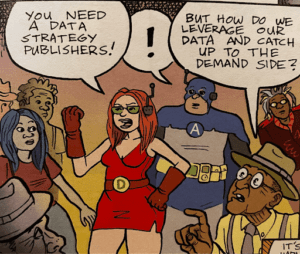 “Data-Driven Thinking” is written by members of the media community and contains fresh ideas on the digital revolution in media.
“Data-Driven Thinking” is written by members of the media community and contains fresh ideas on the digital revolution in media.
Today’s column is written by Paul Rostkowski, president at Varick Media Management.
Viewability has become a major issue in online advertising, having come to represent advertisers’ fear and lack of trust in digital. Brands want their ads to be seen by consumers in safe, fraud-free environments.
Amid the growing concern, the industry has developed standards to define an ad with the highest chance of being seen by a consumer. These standards are a positive move for the industry, and have rightfully earned widespread support, leading to a handful of technology partners entering the market to help measure viewability.
But while these companies may be assuaging marketers’ fears, they remain silent on how they’re actually measuring viewability. This lack of transparency isn’t solving an issue – it’s introducing another, and limiting marketers’ ability to address viewability head-on. It’s impossible to adopt a standard for viewability if the tool used to measure it isn’t highly transparent. The real industry need right now isn’t simply monitoring viewability, but accurate measurement and a transparent methodology.
The many touch points within a digital media transaction, including the publisher, supply-side platform, demand-side platform (DSP), ad server and other peripheral parties, make it difficult for advertisers to know how the viewability technologies arrive at their viewability results. On top of that, each advertiser requires different output from technologies, depending on individual campaigns and desired key performance indicators. For some campaigns, viewability is of the utmost importance. I’ve seen some RFPs for branding campaigns asking for 70% viewable inventory.
So how do we solve this? How do we find a solution to report viewability while also optimizing for the individual campaign goals of each client?
Unfortunately, there is no one solution across the board. Buyers and sellers need the different partners for their individual purpose at each stage of the ad-serving process, regardless of the discrepancies and transactional headaches they may cause. In this case, the solution is to get a deeper understanding of the viewability partner landscape.
This requires careful evaluation and testing of each partner’s capabilities, providing a better understanding of which partner combinations work best for an individual campaign. It’s widely known that not all available solutions are fully integrated or compatible with one another. By evaluating each DSP, third-party verification partner and inventory source, marketers can customize the best formula of partners to ensure delivery of high viewability rates and accurate, uniform measurement for each impression.
When armed with this knowledge, marketers, agencies and the media-buying platforms they employ can optimize campaigns for viewability. For example, if an advertiser wants 70% viewability, but early campaign runs show 50%, tweaks can be made to improve the viewability score. To achieve this, there needs to be a clear explanation of what’s weighted in the score itself. If an algorithmic data element, such as browser type or ad size, accounts for 95% of the score, the advertiser and their partners can spend time focusing on those measures to deliver the best results.
When the variables are transparent and understood, advertisers can spend more time processing them to deliver campaigns that meet their goals. The whole point of viewability is to instill confidence in digital media. The current standards and measurements certainly represent progress, but they are only a half step toward ultimately solving the issue. When advertisers gain visibility into how viewability measurement actually works, then the question of viewability should be solved.
Follow Varick Media Management (@VarickMedia) and AdExchanger (@adexchanger) on Twitter.










